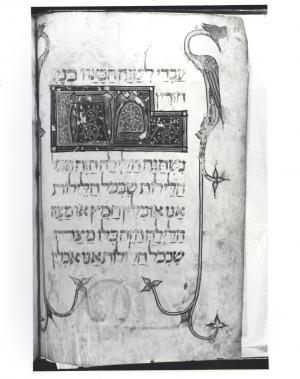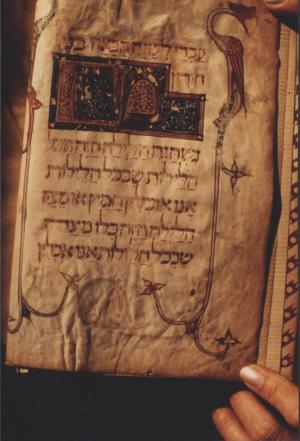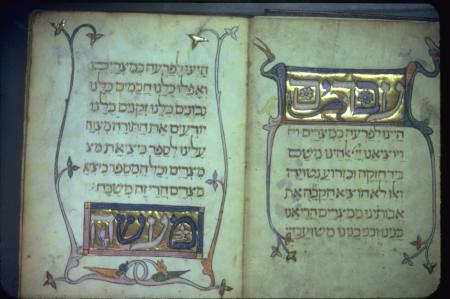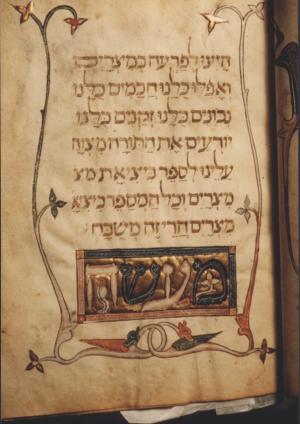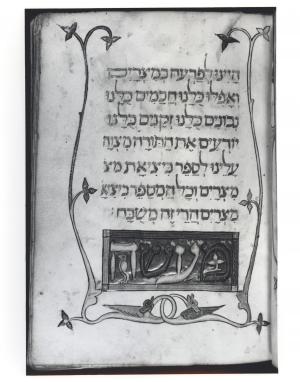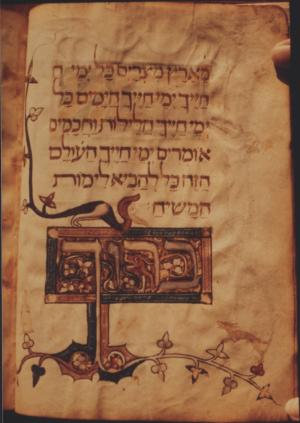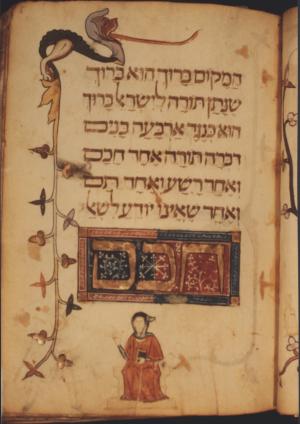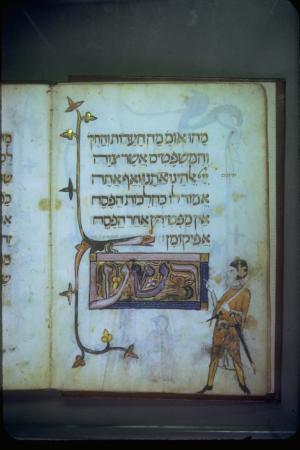Obj. ID: 702
Hebrew Illuminated Manuscripts Prato Haggadah, Spain, c. 1300

The text of the Prato Haggadah is an example of a typical Sephardi rite ending with the Hallel (Ps. 113-114, 115-118) followed by "Yehalelukha ... betishbahot". Unlike other Sephardi Haggadot it ends with the Sephardi piyyutim פסח מצרים and
,מבית אוןwhich are recited during the week of Passover, though not at the end of the ceremony. These two piyyutim appear at the end of the ceremony in the famous Wolf Haggadah, presumably from the north of France (see Kaufmann, 1892, pp. 75-77). The scribe states that he is accustomed to reciting them on the second night of Passover. The Nishmat and Great Hallel (Ps. 136), which
according to the Mishnah (Pes. 10:7), is an optional addition, was not incorporated in the original text of the Sarajevo Haggadah but was added to the Prato Haggadah by an Ashkenazi scribe in Italy together with other piyyutim of the Ashkenazi rite.Because of the unfinished state of its illumination, the manuscript offers an interesting insight into the different stages of the production of an illuminated manuscript. Apart from the first two quires (fols. 1-16v) and two other pages (fols. 33, 40v) that have been completely painted and gilded, most of the other decoration of the text of the original >Haggadah> (fols. 1-53) remains in the draftsman stage. Many pages have undergone the second stage of applying the bole, as a base for the third stage of applying the gold leaf,
which was done in several cases (e.g. fols. 17, 17v, 24, 25, 29, 34, 36, 39v, 47v, 49). Only on very few pages was the fourth stage of adding colour carried out: blue on two pages (fols. 34
and 39v) and blue, red, orange, grey, lilac, green and gold leaf on fol. 36, which was not completed and was very crudely painted, possibly by an apprentice.Some of the motifs, such as foliate scrolls and the kind of marginal grotesques, and text illustrations resemble the text decoration of the Sarajevo Haggadah (Sarajevo, National Museum, see Roth, 1963), which is not so elaborately decorated as the Prato Haggadah. Comparison should be made, for example, between both opening pages of the text (Ha Lahma) with a similar framing scroll, and the architectural tops on the initial word panels. The hare hunt and the building of Pithom and Raamses on fol. 13v of the Sarajevo Haggadah should be compared with the city of Goshen on fol. 11 of the Prato. The dead first-born as a line filler on fol. 20 and a similar Passover lamb on fol. 25v of the Sarajevo is comparable to the illustration line fillers in the Prato (e.g. fols. 11, 17v, 19). However, the figure style of the Sarajevo proves that it is a later manuscript, related to the Italianate style which came to Spain in the second half of the 14th century. The decorative gothic style of the Prato Haggadah is related to the late 13th century French influence on Spanish illumination. Unlike the Sarajevo and other Spanish Haggadot, there are no blank pages between the painted ones, as there are in the Sister Haggadah of the 14th century (London, British Library, Or. 2884, Narkiss, 1982, I, pp. 67-78,figs. 155-208, pl. LI: figs. 173, 188).The missing text of the benedictions before and after the meals in the Prato Haggadah (after fol. 35v) is an enigma, since it could not fit into the middle of a quire and the initial word of the benediction appears at the bottom of the last page (fol. 35v). Likewise, it is not clear whether the blank pages at the end of the original text of the >Haggadah> (fol. 53v-55v) were part of the original manuscript, and were to contain further text of prayers and >piyyutim> for Passover. The original place of the full-page drawn biblical illustrations (fols. 78, 84, 84v) and the additional fully framed pages (fols. 78v-80, 83v, 85) were meant to be attached to the beginning of the manuscript before the text, or at the end, where they are now. It is hard to reconstruct exactly the missing scenes in this biblical cycle. Compared to the biblical cycle of the Sarajevo Hagggadah, the Prato cycle could not have been more extensive andwould not have consisted of more biblical scenes, since unlike those in the Sarajevo, each of the existing ones occupies a full page (fols. 78, 84, 84v). However, since the first full-pagepanel depicts the separation between the waters, there may have been two earlier panels in the Prato: one depicting the unformed earth with the spirit of the Lord hovering over the waters, and the second depicting the division between light and darkness on the first day of creation. The biblical cycle of the Prato Haggadah may have been intended to continue, like that of Sarajevo, up to the giving of the law and the building of the Temple in the Messianic era.
sub-set tree:
Parchment; II + 85 + II leaves; 210 x150 mm; text space 115 x80 mm. The original fols. 1-53 are written in square Sephardi script, in light brown ink, 9 lines per page. Fols. 54-68 are written in square Italo-Ashkenazi script in brown ink, 9 lines per page, partly using the original ruling (fols. 54-56v).
Ruling is by stylus (fol. 64 in ink), 9 horizontal and 1 + 1 vertical lines; pricking is noticeable in most outer, upper and lower margins of the text folios (1-68). Fols. 78-80, 83v-85, which may have been intended to contain full-page illustrations, have continuous lines for frames ruled by plummet, 2 + 2 horizontal and 2 + 2 vertical lines.
Pricking is noticeable in the upper and outer margins of the text folios (1-68).
11 quires of 8 leaves each, except for IX7 (3 +4, a single folio, probably blank, is missing between fols. 70 and 71), X6. Quire V of 8 leaves may have had 2 additional folios, which included the benediction for the third cup of wine, the order of appetizers, Grace after meals and the pouring of the fourth cup of wine, now missing after fol. 35v, which ends with the initial word ברוך "Blessed".
Fols. 53v, 68v-77v, 80v-83 and 85v are blank.
20th century brown leather with gold-tooled floral frame on front and back and blind-tooled decoration on the spine. The book is kept in a modern box. The restoration was funded by the Samuel Kress Foundation.
The text and biblical illuminations are not complete. Some are mere pen drawings, others are partly coloured using blue, orange, white, green, yellow, violet and pink, with burnished gold and silver. Human faces, hands and some furniture are not coloured.
A. 3 full-page drawings for a biblical cycle which was never completed (fols. 78, 84, 84v)
B. 15 text illustrations (fols. 5, 5v, 6v, 10, 11, 14v, 16, 17v 19, 22, 27v, 28, 29, 30, 36) four of which are full pages (fols. 27v, 29, 30, 36)
C. Numerous initial word panels written in display script. The letters are either in burnished gold and set against alternating blue and pink decorated backgrounds (e.g. fols. 1v, 4, 12, 29) or they are painted on burnished gold backgrounds (e.g. fols. 1, 3, 6v,13, 33). Various leaves, scrolls, dragons, grotesques and birds are scattered among the letters. Most pages are decorated along the margins with foliate scrolls, sometimes with stylized trefoil leaves. They are combined with dragons, grotesques, birds and various animals such as rabbits, deer and hounds (some hunting, e.g. fols. 1, 4v, 9v-10, 12, 33, 41v). Repeated first and last words of verses in some piyyutim are written in display script one above the other forming framed panels on either one or both sides of the text (e.g. fols. 45-52v). Of the 89 decorated pages in the Haggadah, only 30 were painted completely. From fol. 17 onward most decoration is at an early stage, with the exception of two fully colored pages (fols. 33, 40), one that is almost finished (fol. 36) and three in which burnished gold and blue pigment were applied (fols. 29, 34, 39v) and six with gold alone (e.g. fols. 17, 17v, 24, 25, 47v, 49). Most have outlined initial words and pen-drawn decoration, some with bole, which was to be covered with gold.






